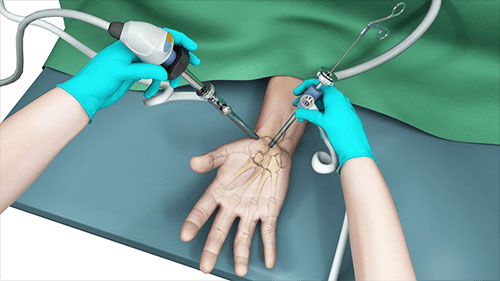Hand and Wrist Arthroscopy is a minimally invasive surgical procedure used to diagnose and treat various conditions affecting the hand and wrist joints. During this procedure, a small camera called an arthroscope is inserted into the joint through tiny incisions. The arthroscope allows the surgeon to see inside the joint on a screen, enabling precise diagnosis and treatment of joint issues with minimal disruption to surrounding tissues.

Indications for Hand and Wrist Arthroscopy:
Hand and wrist arthroscopy can be used to treat a variety of conditions, including:
Wrist Arthritis:
- Osteoarthritis, rheumatoid arthritis, or post-traumatic arthritis (resulting from previous injuries) can cause pain, stiffness, and swelling in the wrist joint.
- Arthroscopic Treatment: The surgeon can remove damaged tissue, bone spurs, or loose cartilage, and perform procedures to improve joint function and reduce pain. In advanced cases, arthroscopy may be used to prepare the joint for a wrist replacement procedure.
Wrist Impingement:
- Wrist impingement occurs when bone spurs or soft tissue growth causes parts of the wrist joint to become pinched.
- Arthroscopic Treatment: The surgeon can remove the bone spurs or excess tissue, improving joint movement and reducing pain.
TFCC (Triangular Fibrocartilage Complex) Tears:
- The TFCC is a structure in the wrist that provides stability to the joint. Tears of the TFCC can cause pain, particularly with wrist rotation.
- Arthroscopic Treatment: Arthroscopy can be used to inspect the TFCC, repair or debride the torn tissue, and relieve pain or instability.
Carpal Tunnel Syndrome:
- Carpal tunnel syndrome is a condition caused by compression of the median nerve at the wrist, resulting in numbness, tingling, and weakness in the hand.
- Arthroscopic Treatment: The surgeon can release pressure on the median nerve by cutting the ligament that forms the roof of the carpal tunnel, thereby alleviating symptoms.
Wrist Instability:
- Wrist instability can occur when the ligaments that support the wrist joint are stretched or torn, leading to weakness or frequent dislocations.
- Arthroscopic Treatment: The surgeon can inspect and repair damaged ligaments or tissues and help restore stability to the wrist joint.
Wrist Fractures:
- Fractures of the bones in the wrist, particularly those involving the joint surfaces, may be treated with arthroscopy, especially when the fractures are small or stable.
- Arthroscopic Treatment: The surgeon can use the arthroscope to remove bone fragments, clean the joint, and repair damaged tissues, assisting in the healing process.
Synovitis (Inflammation of Joint Lining):
- Synovitis is the inflammation of the synovial membrane that lines the joints. It can occur due to arthritis or injury, causing pain, swelling, and limited movement.
- Arthroscopic Treatment: The surgeon can remove the inflamed tissue and debris, relieving pain and improving function.
Ganglion Cysts:
- Ganglion cysts are non-cancerous lumps that commonly form around the wrist joint, often causing pain or restricting movement.
- Arthroscopic Treatment: The cyst can be removed, and any surrounding tissue that may be causing pressure on the joint can also be treated.
Cartilage Damage:
- Cartilage damage in the wrist joint can result in pain and limited movement.
- Arthroscopic Treatment: The surgeon can remove damaged cartilage or perform procedures like microfracture to stimulate new cartilage growth or smooth rough surfaces to promote healing.
How Hand and Wrist Arthroscopy is Performed:
Preoperative Preparation:
- Consultation: Before the procedure, the surgeon will review your medical history, perform a physical exam, and often conduct imaging studies like X-rays or MRIs to evaluate the condition of the joint.
- Anesthesia: Hand and wrist arthroscopy is typically performed under local anesthesia (numbing the area around the wrist) or regional anesthesia (numbing the whole arm). In some cases, general anesthesia may be used.
- Positioning: You will be positioned so that the surgeon has easy access to the wrist joint. This may involve lying on your back with your arm positioned to ensure the wrist is accessible.
Surgical Procedure:
- Incisions: The surgeon makes two or three small incisions (about 1–2 cm each) around the wrist to insert the arthroscope and specialized instruments.
- Inspection: The arthroscope is inserted through one incision to provide real-time visual access to the wrist joint, while the surgeon uses other incisions to insert tools to perform the treatment.
- Treatment: Based on the diagnosis, the surgeon may:
- Remove damaged tissue, cartilage, or bone spurs.
- Repair torn ligaments or tendons.
- Remove cysts or clean out inflamed tissue.
- Perform microfracture or other cartilage restoration techniques.
- Closure: Once the necessary treatments are completed, the incisions are closed with sutures, and a sterile dressing is applied.
Postoperative Care:
- Recovery Room: After the procedure, you will be monitored as the anesthesia wears off. You may experience some pain and swelling, which can typically be managed with medications and ice therapy.
- Bracing or Splinting: You will likely be given a splint or brace to immobilize the wrist and reduce movement during the initial recovery period.
- Pain Management: Pain is usually mild to moderate and can be controlled with oral medications. Elevation and ice can help reduce swelling.
- Rehabilitation: Once the swelling and pain decrease, physical therapy may begin to help restore strength, flexibility, and mobility in the wrist.
Advantages of Hand and Wrist Arthroscopy:
- Minimally Invasive: Smaller incisions mean less disruption to surrounding tissues, reduced scarring, and a quicker recovery compared to open surgery.
- Faster Recovery: Most patients experience faster healing, less pain, and a quicker return to normal activities compared to traditional surgery.
- Reduced Risk of Infection: Smaller incisions reduce the risk of infection compared to open procedures.
- Better Visualization: The arthroscope provides a clear view of the joint, allowing the surgeon to make more accurate diagnoses and treatments.
- Outpatient Procedure: Many cases can be performed on an outpatient basis, meaning the patient can go home the same day.
Risks and Complications:
While hand and wrist arthroscopy is generally safe, there are some potential risks and complications, including:
- Infection: Though rare, there is always a risk of infection at the incision sites.
- Nerve Injury: The procedure may involve a small risk of nerve injury, which can result in temporary or permanent numbness or weakness in the hand or wrist.
- Bleeding: Some bleeding may occur during or after the procedure.
- Stiffness: Some patients may experience stiffness in the wrist joint, particularly if the joint is not properly rehabilitated after surgery.
- Recurrent Symptoms: In some cases, symptoms may return if the underlying problem isn’t fully resolved, or if healing does not proceed as expected.
Recovery and Rehabilitation:
Immediate Postoperative Care:
- After surgery, you will need to rest the wrist and may need to wear a splint or brace to reduce movement and promote healing.
- Ice and elevation will help reduce swelling and pain in the early days after surgery.
- Pain medications will be prescribed to manage discomfort.
Physical Therapy:
- Phase 1 (Initial Recovery): Focus on reducing swelling and pain. Range-of-motion exercises typically begin soon after surgery to prevent stiffness.
- Phase 2 (Strengthening): Once pain and swelling are under control, strengthening exercises will help restore muscle strength and joint stability.
- Phase 3 (Return to Activity): Gradually, patients can return to normal activities, with more demanding exercises for those who need full wrist function, such as athletes or people with physically demanding jobs.
Full Recovery: The typical recovery time is 4–6 weeks, although it may take longer for some patients, especially if more extensive repairs were needed or if the injury was severe.


